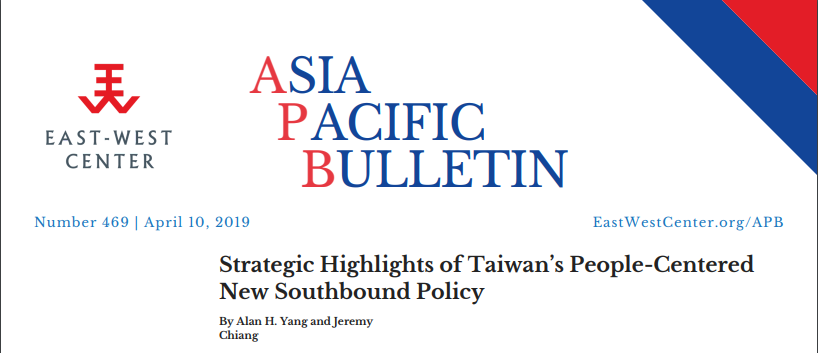Launched in 2016, Taiwan’s New Southbound Policy (NSP) is now in its third year. Regarded as Taiwan’s “regional strategy for Asia,” the NSP is the island’s response to regional dynamics in South and Southeast Asia. The NSP also articulates Taiwan’s strategic interests and practices echoing major powers’ approaches and initiatives toward the region. The strategic highlights of the NSP are characterized by the “4S” approach: systemizing Taiwan’s regional strategy for Asia, strategizing Taiwan’s importance, synergizing public and private partnerships, and structuring social links between Taiwan and regional neighbors.
Systemizing Taiwan’s Regional Strategy for Asia
President Tsai Ing-wen’s New Southbound Policy reflects a detailed conceptualization of national interests and careful inter-ministerial input. In comparison with the “Go South” policies in the 1990s, the NSP puts increased emphasis on local agendas and developmental needs. While the “Go South” policies concentrated on economic cooperation and state-owned-enterprise (SOE) investments, the NSP seeks deeper socio-economic connectivity between Taiwan and its neighboring communities.
In 2018, more than 2.3 million visitors from the NSP partner countries visited Taiwan, a 15% increase from the previous year. Institutional linkages such as a recent MoU on talent cultivation cooperation concluded by high schools and universities from Taiwan and Vietnam have also enabled pragmatic efforts in multiple social layers.
A more systematic Taiwan-Asia partnership achieves two important policy objectives. First, it recognizes and supports South and Southeast Asia as the driving forces of Asian integration. Second, it promotes Taiwan’s government and civilian connectivity with local counterparts and stakeholders in Asia, which should be in line with the regional agenda and local needs of Asian development.
Strategizing Taiwan’s Importance
Despite being challenged by China’s mounting influence, and limited by the various “One China” policies of different countries, Taiwan has a long-standing importance for Asia. As former Indonesian foreign minister Marty Natalegawa writes in his recent book: “Taiwan, as an economic and social entity, has an important role to play in our region.” The aim of the NSP is to highlight Taiwan’s past and continued contributions to the regional community and to its people, and to seek increased cooperation from regional partners while also acknowledging constrainted official policy stances.
The NSP shows that Taiwan is not only an active partner for regional development, it is also a caring member of the regional community. For example, Taiwan Water Corporation has planned to build a water purification plant in Malang, East Java to meet local needs. This is based on a build-operate-transfer (BOT) model, which will include a feasible management model that may be possible to introduce to other areas. Taiwan’s Ministry of Health and Welfare has also facilitated training programs for over 300 medical and public health personnel from nine NSP partner countries.
While Taiwan does not have the resources of Japan, China, or the United States, its commitment to Asia is just as strong. This island country wishes to strategize and expand its own presence in the ASEAN-led regional community, and also to rebrand Taiwan as a facilitator of regional prosperity and local economic growth.
Synergizing Public and Private Partnerships
Synergizing public and private partnerships by going beyond official channels and institutions is also an important component of the NSP. The policy is not a unilateral initiative of Taiwan’s government, but a partnered action between government and civil society, while also linking out to governments and civil societies in South and Southeast Asia.
For example, in the Five Flagship Programs of the NSP, Taiwan has been promoting a “One Country, One Center” project in its Medical Cooperation and Industrial Supply Chains program, tasking six major Taiwanese hospitals each with opening or linking up with prestige medical centers in Malaysia, Thailand, Vietnam, Indonesia, the Philippines, and India. Additionally, for the Regional Agriculture program, Taiwan’s Council of Agriculture has activated a Modern Agriculture Demo Farm in Karawang, a province in West Java, in collaboration with the Indonesian Ministry of Agriculture. Both of these projects involve technological knowledge sharing and quality training, while also showcasing Taiwan’s commitment to combining governmental and civilian resources to share with civil organizations and governments abroad.
Structuring Social Links Between Taiwan and Regional Neighbors
The NSP has also structured new social links between Taiwan and regional neighbors. Traditional manufacturing industries were once regarded as the dominant Taiwanese presence in Southeast Asia; however, as bidirectional exchanges have become more diverse, businessmen, students, young professionals, NGOs, start-up enterprises, and artists are now moving into South and Southeast Asia, helping spread Taiwan’s well-celebrated “Warm Power.” Taiwan has also initiated the Asia Engagement Consortium (AEC) in 2018, which includes leading think tanks, civil society organizations, and academic institutions in Taiwan for the purpose of widening networks in South and Southeast Asia, and further linking up with the region.
On the other side, Southeast Asian communities based in Taiwan actively seek to set up new networks and institutions, such as the Vietnam Expert Association in Taiwan (VNEAT) — a local network in talent cooperation that brings together Vietnamese experts from various fields in Taiwan — and the nongovernmental organization Living Arts International, which also established a branch in Taipei City last year. The Living Arts branch in Phnom Penh will help facilitate cooperation between Taiwan artists and their counterparts in Cambodia, Laos, Myanmar, Thailand, and Vietnam.
The New Southbound Policy: What’s Next?
The next step for the NSP is also a further step for Taiwan’s Asia engagement and Indo-Pacific strategic approach. The above-mentioned results highlight the NSP’s achievements in the system, strategy, synergy, and structure of Taiwan’s improved relations with the region. For the NSP’s next phase, it is necessary to transform the originally strategic rationale and initiative into a deeper cultural understanding and social compatibility, and properly respond to the mentioned challenges, in order to really transform the NSP into an important force that ensures the survival of Taiwan.
This article is published on Asia Pacific Bulletin, No. 469, East West Center, Washington, US.
Download free copy here: https://www.eastwestcenter.org/system/tdf/private/apb469.pdf?file=1&type=node&id=37102
